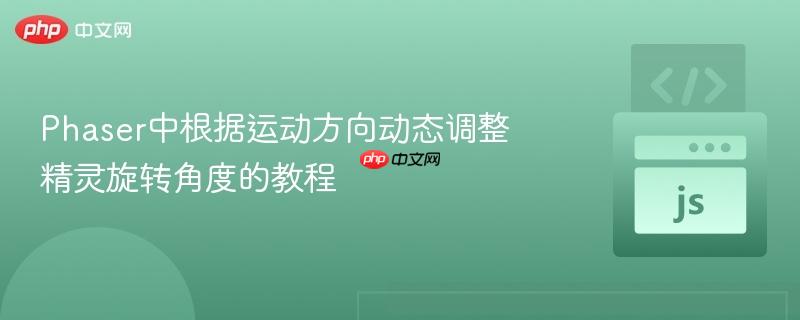
本教程详细介绍了如何在phaser 3游戏中,使精灵根据其当前运动方向自动调整旋转角度,尤其是在发生碰撞后。文章将涵盖初始设置、世界边界碰撞处理以及精灵间碰撞处理,通过利用phaser的物理系统和向量数学,确保精灵始终面向其速度向量的方向,从而提升游戏视觉真实感和交互体验。
在Phaser游戏中,创建动态且响应迅速的精灵是提升用户体验的关键。一个常见的需求是让精灵的视觉方向与其运动方向保持一致,特别是在发生碰撞导致速度方向改变之后。本文将指导您如何实现这一功能,确保您的精灵能够“面向”它们前进的方向。
首先,我们需要设置一个基本的Phaser游戏环境,并创建一个物理精灵组。我们将使用Phaser的Arcade物理系统,并为精灵赋予初始速度。
document.body.style = 'margin:0;'; // 移除页面默认边距
var config = {
type: Phaser.AUTO,
width: 800, // 调整宽度以适应示例
height: 600, // 调整高度以适应示例
physics: {
default: 'arcade',
arcade: {
gravity: { y: 0 }, // 无重力,方便演示自由移动
debug: false // 调试模式,可显示物理边界
}
},
scene: { create, update } // 添加update函数用于相机控制
};
var game = new Phaser.Game(config);
var controls; // 用于相机控制
function create () {
// 创建一个简单的纹理用于精灵,这里使用一个白色三角形模拟“光子”
let graphics = this.make.graphics();
graphics.fillStyle(0xffffff);
graphics.fillTriangle(0, 0, 10, 5, 0, 10); // 绘制一个指向右侧的三角形
graphics.generateTexture('photon_img', 10, 10); // 生成名为'photon_img'的纹理
// 创建精灵组
this.photons = this.physics.add.group({
key: "photon_img", // 使用我们生成的纹理
repeat: 11, // 创建12个精灵(1个初始+11个重复)
setXY: { x: 50, y: 50, stepX: 60, stepY: 60 }, // 设置初始位置和步长
});
// 遍历精灵组,设置每个精灵的物理属性和初始状态
this.photons.children.iterate((child) => {
child.body.bounce.set(1); // 设置完全弹性碰撞
child.setVelocity(Phaser.Math.Between(-200, 200), Phaser.Math.Between(-200, 200)); // 随机初始速度
child.body.collideWorldBounds = true; // 允许与世界边界碰撞
child.body.onWorldBounds = true; // 开启世界边界碰撞事件监听
// 根据初始速度设置精灵的初始旋转角度
let initialAngle = (new Phaser.Math.Vector2(child.body.velocity)).angle();
child.setRotation(initialAngle);
});
// 设置相机控制(可选,如果不需要可移除)
const cursors = this.input.keyboard.createCursorKeys();
const controlConfig = {
camera: this.cameras.main,
left: cursors.left,
right: cursors.right,
up: cursors.up,
down: cursors.down,
acceleration: 0.06,
drag: 0.0005,
maxSpeed: 1.0,
};
controls = new Phaser.Cameras.Controls.SmoothedKeyControl(controlConfig);
// 添加文本提示
this.add.text(10, 10, '精灵会根据运动方向旋转')
.setScale(1.5)
.setOrigin(0)
.setStyle({fontStyle: 'bold', fontFamily: 'Arial', color: '#00ff00'});
}
function update (time, delta) {
// 更新相机控制(如果已设置)
if (controls) {
controls.update(delta);
}
}关键点说明:
当精灵与游戏世界的边界发生碰撞时,其速度方向会改变。我们需要监听worldbounds事件并更新精灵的旋转。
// ... (接上面的create函数)
// 监听世界边界碰撞事件
this.physics.world.on('worldbounds', (body) => {
// 'worldbounds'事件的callback参数是发生碰撞的物理体(body)
// 从物理体获取其所属的游戏对象(gameObject)
let photon = body.gameObject;
if (photon) {
// 根据新的速度向量计算旋转角度
let newAngle = (new Phaser.Math.Vector2(body.velocity)).angle();
photon.setRotation(newAngle);
}
});
// ... (create函数结束)解释:
除了世界边界碰撞,精灵之间也可能发生碰撞。当两个精灵相互碰撞时,它们的速度方向同样会改变,因此也需要更新它们的旋转。
// ... (接上面的create函数)
// 添加精灵组内部的碰撞检测
this.physics.add.collider(this.photons, this.photons, (p1, p2) => {
// p1 和 p2 是发生碰撞的两个精灵对象
// 更新第一个精灵的旋转
let newAngle1 = (new Phaser.Math.Vector2(p1.body.velocity)).angle();
p1.setRotation(newAngle1);
// 更新第二个精灵的旋转
let newAngle2 = (new Phaser.Math.Vector2(p2.body.velocity)).angle();
p2.setRotation(newAngle2);
});
// ... (create函数结束)解释:
将上述所有部分整合,您将得到一个完整的Phaser游戏示例,其中精灵会根据其运动方向动态旋转:
<!DOCTYPE html>
<html>
<head>
<title>Phaser精灵动态旋转教程</title>
<script src="//cdn.jsdelivr.net/npm/phaser/dist/phaser.min.js"></script>
<style>
body { margin: 0; }
</style>
</head>
<body>
<script>
document.body.style = 'margin:0;';
var config = {
type: Phaser.AUTO,
width: 800,
height: 600,
physics: {
default: 'arcade',
arcade: {
gravity: { y: 0 },
debug: false // 设置为true可以显示物理调试信息
}
},
scene: { create, update }
};
var game = new Phaser.Game(config);
var controls;
function create () {
// 创建一个简单的纹理用于精灵
let graphics = this.make.graphics();
graphics.fillStyle(0xffffff);
graphics.fillTriangle(0, 0, 10, 5, 0, 10); // 绘制一个指向右侧的三角形
graphics.generateTexture('photon_img', 10, 10);
// 创建精灵组
this.photons = this.physics.add.group({
key: "photon_img",
repeat: 11,
setXY: { x: 50, y: 50, stepX: 60, stepY: 60 },
});
// 遍历精灵组,设置每个精灵的物理属性和初始状态
this.photons.children.iterate((child) => {
child.body.bounce.set(1); // 完全弹性碰撞
child.setVelocity(Phaser.Math.Between(-200, 200), Phaser.Math.Between(-200, 200)); // 随机初始速度
child.body.collideWorldBounds = true; // 与世界边界碰撞
child.body.onWorldBounds = true; // 开启世界边界碰撞事件监听
// 根据初始速度设置精灵的初始旋转角度
let initialAngle = (new Phaser.Math.Vector2(child.body.velocity)).angle();
child.setRotation(initialAngle);
});
// 监听世界边界碰撞事件
this.physics.world.on('worldbounds', (body) => {
let photon = body.gameObject;
if (photon) {
let newAngle = (new Phaser.Math.Vector2(body.velocity)).angle();
photon.setRotation(newAngle);
}
});
// 添加精灵组内部的碰撞检测
this.physics.add.collider(this.photons, this.photons, (p1, p2) => {
// 更新第一个精灵的旋转
let newAngle1 = (new Phaser.Math.Vector2(p1.body.velocity)).angle();
p1.setRotation(newAngle1);
// 更新第二个精灵的旋转
let newAngle2 = (new Phaser.Math.Vector2(p2.body.velocity)).angle();
p2.setRotation(newAngle2);
});
// 相机控制设置(可选)
const cursors = this.input.keyboard.createCursorKeys();
const controlConfig = {
camera: this.cameras.main,
left: cursors.left,
right: cursors.right,
up: cursors.up,
down: cursors.down,
acceleration: 0.06,
drag: 0.0005,
maxSpeed: 1.0,
};
controls = new Phaser.Cameras.Controls.SmoothedKeyControl(controlConfig);
this.add.text(10, 10, '精灵会根据运动方向旋转')
.setScale(1.5)
.setOrigin(0)
.setStyle({fontStyle: 'bold', fontFamily: 'Arial', color: '#00ff00'});
}
function update (time, delta) {
if (controls) {
controls.update(delta);
}
}
</script>
</body>
</html>通过遵循本教程的步骤,您可以轻松地在Phaser游戏中实现精灵根据其运动方向动态旋转的功能,无论是与世界边界还是与其他精灵发生碰撞,都能保持视觉上的连贯性和真实感。
以上就是Phaser中根据运动方向动态调整精灵旋转角度的教程的详细内容,更多请关注php中文网其它相关文章!

每个人都需要一台速度更快、更稳定的 PC。随着时间的推移,垃圾文件、旧注册表数据和不必要的后台进程会占用资源并降低性能。幸运的是,许多工具可以让 Windows 保持平稳运行。

Copyright 2014-2025 https://www.php.cn/ All Rights Reserved | php.cn | 湘ICP备2023035733号